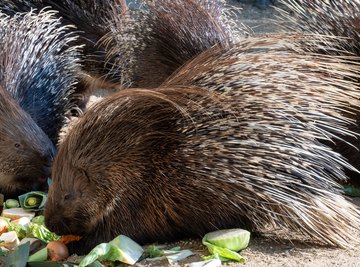
While most animals are covered in fur, feathers, scales or shells, some animals have prickly spines as their outermost covering. These prickly animals primarily use their coverings as a form of self-defense from predators. Many of these animals live in the wild, although some of them, like the hedgehog, may thrive in domesticated environments, often as pets.
Porcupine
The body of a porcupine is covered with up to 30,000 sharp spines. A rodent associated with guinea pigs, the porcupine makes use of its spiny covering to drive predators away. When threatened with an attack, porcupines usually stamp their feet, shake their tails, and rattle their spines as a self-defense mechanism; however, porcupines are not aggressive animals, subsisting mainly on plants, fruits and roots.
Hedgehog
The hedgehog is a prickly mammal that is covered with brown- and white-colored spines, although its head is also covered with hair. By way of protecting itself from predators, the hedgehog pulls its spines erect or reduces itself into a ball so as to keep its vulnerable belly out of the predators’ sight. While the hedgehog is sometimes mistaken with the porcupine, some of the most remarkable differences include their color, size and length of spines. The hedgehog is smaller, has a brownish white color, and much shorter spines.
Pufferfish
The pufferfish is named so for the way it bloats itself into more than double its size in order to keep predators and other threats at bay. This fish gulps in both air and water so as to inflate itself into a rounder and bigger creature; when this happens, the sharp spines on its skin become more erect and prominent. Due to its sharp mouth, the pufferfish mainly survives on crabs, shellfish, sea stars and sea urchins.
Armadillo Lizard
The armadillo lizard -- not to be confused with an armadillo -- has a very tough body covering of thornlike scales. It has very sensitive nostrils shaped like tubes, which allow it to sense food as well as predators. When threatened, the armadillo lizard curls itself up so that its tail is anchored by its jaw and its unprotected belly area is covered by its spiny scales. The way this lizard defends itself resembles the way an armadillo defends itself by rolling itself into a ball for protection.
References
About the Author
Steve Johnson is an avid and passionate writer with more than five years of experience. He's written for several industries, including health, dating and Internet marketing, as well as for various websites. He holds a bachelor's degree from the University of Texas.
